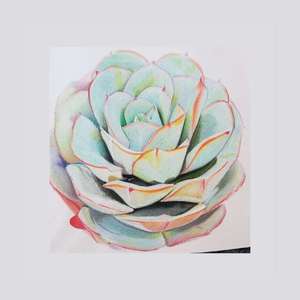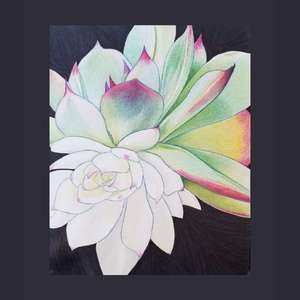文章
Andy
2018年12月26日

Facebook Pinterest Twitter Google+ WhatsApp StumbleUponTurmeric is a superfood and has many medicinal benefits. Growing turmeric in pots is not so difficult if you follow this how-to guide.


USDA Zones— 7b – 11, below these zones grow it from spring to fall
(adsbygoogle = window.adsbygoogle || []).push({});
Difficulty— Easy to Moderate
Other Names— Curcuma, Curcuma aromatica, Curcuma domestica, Curcumae longa, Curcumae Longae Rhizoma, Curcumin, Curcumine, Curcuminoid, Curcuminoïde, Curcuminoïdes, Curcuminoids, Halada, Haldi, Haridra, Indian Saffron, Nisha, Pian Jiang Huang, Racine de Curcuma, Radix Curcumae, Rajani, Rhizoma Cucurmae Longae, Safran Bourbon, Safran de Batallita, Safran des Indes, Turmeric Root, Yu Jin.
Soil pH— Slightly acidic to slightly alkaline soil
Turmeric (Curcuma longa) is obtained from the underground tubers or rhizomes. Originated in India, it is now cultivated throughout the tropical Asia and in smaller extent in other subtropical and tropical parts of the world.
(adsbygoogle = window.adsbygoogle || []).push({}); Turmeric plants look good too, you can grow them outdoors to get a tropical look in your garden.

Where to Find the Rhizome or Turmeric Plant
As you may already know, turmeric grows from the rhizomes like ginger. The easiest way to find them is to search for fresh turmeric rhizome in organic food stores. Also, try searching for it in the local garden center or seed store. Alternatively, you can find a turmeric plant or rhizome online.
Choosing a Pot
For growing turmeric in pots, choose a large pot as this amazing herb can easily exceed the height of 1 m. Pot should be at least 12 inches deep and 12-18 inches wide so that the plant can spread its tubers freely. Plant 1 or 2 rhizomes in such a pot.
Planting Turmeric
The best season to plant turmeric is spring or summer when the temperature starts to stay above 54 F (12 C), but if you are living in tropics, it can be planted throughout the year.
After you have got the rhizome follow the steps below for planting:
Break large rhizome into small pieces, each one should have at least two or three buds.Fill a pot with rich organic soil that is moist and well-drained.Place it about 2 inches (5 cm) below the soil surface, with the buds facing up.Water the pot thoroughly.Requirements for Growing Turmeric in Containers
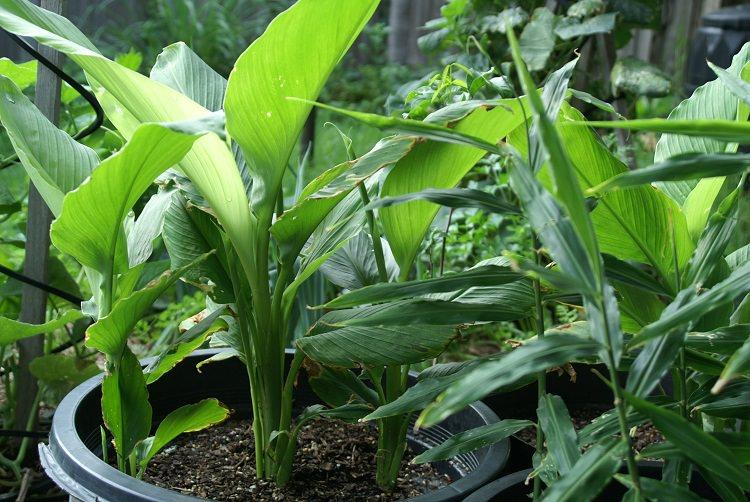

Growing turmeric is similar to ginger, it requires warm and humid climate to thrive. If you live in a cool temperate climate or if you’re short of space and want to grow your own turmeric rhizomes then learn how to grow turmeric in pots.
Position
The position must be sheltered from the wind. In tropics, the plant is grown in dappled shade and does not like all day long intense direct sun, considering this keep the turmeric plant in partial sun in the warmer zones (USDA Zone 9 and above). However, in temperate climates, provide it full sun for optimum growth, some shade in the afternoon would be okay.
Soil
Plant turmeric in a light and loamy soil that is rich in organic matters. Use well-drained soil otherwise the plant will suffer.
Water
Watering requirements are similar to ginger. Keep the soil moist throughout the growing season from spring to fall and do not hesitate to mist the foliage in dry weather to increase the humidity level around the plant.
If growing turmeric in a warmer region, keep watering the plant to maintain moist soil in winters too.
Temperature
The ideal temperature range for growing turmeric is between 68-95 F (20-35 C). When the temperature drop below 50 F (10 C) the plant suffers.
Turmeric Plant Care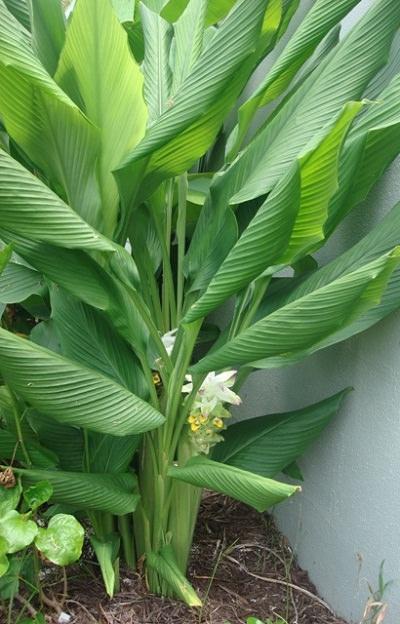

Overwintering
Since you are growing turmeric in a pot, move the plant inside even in low-light conditions. Because you have to only overwinter the roots. It is important that when you grow turmeric indoors maintain a constant ambient temperature of approximately 64 F (18 C).
Overwintering turmeric on ground
If you’re growing turmeric in true tropical climate then you don’t need to care about winter. But in warm temperate zones (below USDA Zones 9b and down to 7) to overwinter your turmeric plants, reduce watering around the end of fall and when the leaves begin to wilt and turn yellow due to temperature drop cut the plant back to the ground so that it can hibernate. It will perk up again in the spring.
If you want to grow turmeric in cooler areas (below zone 7) then you have to dig up the rhizomes to save them from freezing. For this, dig up the rhizomes and rinse off excess soil from them, snap off rotting pieces. Air dry them and store in a cool and dry place until spring.
Fertilizer
Fertilize turmeric every month with an all-purpose liquid fertilizer during the growing season. Application of manure or compost also helps.
Pruning
The turmeric plant should not be pruned. It is sufficient if you remove dried leaves time to time.
Pests and Diseases
Turmeric plant is not prone to any serious disease or pests. However, red spider mites and scales can become a problem. In diseases, it only suffers from rhizome rot and leaf spot. Rot appears when the plant is grown in waterlogged soil. Therefore, it is important to grow turmeric in well-drained soil.
Harvesting
Turmeric plant takes 8 to 10 months to mature. Harvesting is done once the leaves become yellow and stems start to dry. Harvesting turmeric is not difficult, simply dig up the plant entirely, including the roots.
(adsbygoogle = window.adsbygoogle || []).push({});
Cut the required amount and then replant the remaining part again to get a new plant growing.
After you cut the rhizome, follow the steps below to process it:
Boil the rhizomes.Carefully remove the skin from rhizomes.Place the bare rhizomes in a tray.Dry them by exposing to sunlight.
When the rhizomes are dry, grind them and store your homemade organic fresh turmeric powder in an air tight container.
Turmeric Uses and Benefits
Turmeric powder has many medicinal properties that have long been known in the India and China. Turmeric is termed as ‘Super Food‘ probably the most powerful natural anti-inflammatory and antioxidant. It is used as an anti-depressant and plays a protective role against Alzheimer’s disease and against different types of cancers. Turmeric powder is the most prominent ingredient in almost all kind of curry recipes, a pinch of it is used to provide pretty orange color. Its leaves are also useful. Young shoots and flowers are used in Thai cuisines while the leaves are used to flavor the fish in Indonesia.
One thing you did not know and surprise you is the addition of pepper in a diet as it contains piperine helps in the absorption of turmeric. Especially the black pepper, it can tenfold the benefits of this superfood.
Pin it (adsbygoogle = window.adsbygoogle || []).push({});


Facebook Pinterest Twitter Google+ WhatsApp StumbleUpondiv.OUTBRAIN{padding:30px}


USDA Zones— 7b – 11, below these zones grow it from spring to fall
(adsbygoogle = window.adsbygoogle || []).push({});
Difficulty— Easy to Moderate
Other Names— Curcuma, Curcuma aromatica, Curcuma domestica, Curcumae longa, Curcumae Longae Rhizoma, Curcumin, Curcumine, Curcuminoid, Curcuminoïde, Curcuminoïdes, Curcuminoids, Halada, Haldi, Haridra, Indian Saffron, Nisha, Pian Jiang Huang, Racine de Curcuma, Radix Curcumae, Rajani, Rhizoma Cucurmae Longae, Safran Bourbon, Safran de Batallita, Safran des Indes, Turmeric Root, Yu Jin.
Soil pH— Slightly acidic to slightly alkaline soil
Turmeric (Curcuma longa) is obtained from the underground tubers or rhizomes. Originated in India, it is now cultivated throughout the tropical Asia and in smaller extent in other subtropical and tropical parts of the world.
(adsbygoogle = window.adsbygoogle || []).push({}); Turmeric plants look good too, you can grow them outdoors to get a tropical look in your garden.


Where to Find the Rhizome or Turmeric Plant
As you may already know, turmeric grows from the rhizomes like ginger. The easiest way to find them is to search for fresh turmeric rhizome in organic food stores. Also, try searching for it in the local garden center or seed store. Alternatively, you can find a turmeric plant or rhizome online.
Choosing a Pot
For growing turmeric in pots, choose a large pot as this amazing herb can easily exceed the height of 1 m. Pot should be at least 12 inches deep and 12-18 inches wide so that the plant can spread its tubers freely. Plant 1 or 2 rhizomes in such a pot.
Planting Turmeric
The best season to plant turmeric is spring or summer when the temperature starts to stay above 54 F (12 C), but if you are living in tropics, it can be planted throughout the year.
After you have got the rhizome follow the steps below for planting:
Break large rhizome into small pieces, each one should have at least two or three buds.Fill a pot with rich organic soil that is moist and well-drained.Place it about 2 inches (5 cm) below the soil surface, with the buds facing up.Water the pot thoroughly.Requirements for Growing Turmeric in Containers


Growing turmeric is similar to ginger, it requires warm and humid climate to thrive. If you live in a cool temperate climate or if you’re short of space and want to grow your own turmeric rhizomes then learn how to grow turmeric in pots.
Position
The position must be sheltered from the wind. In tropics, the plant is grown in dappled shade and does not like all day long intense direct sun, considering this keep the turmeric plant in partial sun in the warmer zones (USDA Zone 9 and above). However, in temperate climates, provide it full sun for optimum growth, some shade in the afternoon would be okay.
Soil
Plant turmeric in a light and loamy soil that is rich in organic matters. Use well-drained soil otherwise the plant will suffer.
Water
Watering requirements are similar to ginger. Keep the soil moist throughout the growing season from spring to fall and do not hesitate to mist the foliage in dry weather to increase the humidity level around the plant.
If growing turmeric in a warmer region, keep watering the plant to maintain moist soil in winters too.
Temperature
The ideal temperature range for growing turmeric is between 68-95 F (20-35 C). When the temperature drop below 50 F (10 C) the plant suffers.
Turmeric Plant Care


Overwintering
Since you are growing turmeric in a pot, move the plant inside even in low-light conditions. Because you have to only overwinter the roots. It is important that when you grow turmeric indoors maintain a constant ambient temperature of approximately 64 F (18 C).
Overwintering turmeric on ground
If you’re growing turmeric in true tropical climate then you don’t need to care about winter. But in warm temperate zones (below USDA Zones 9b and down to 7) to overwinter your turmeric plants, reduce watering around the end of fall and when the leaves begin to wilt and turn yellow due to temperature drop cut the plant back to the ground so that it can hibernate. It will perk up again in the spring.
If you want to grow turmeric in cooler areas (below zone 7) then you have to dig up the rhizomes to save them from freezing. For this, dig up the rhizomes and rinse off excess soil from them, snap off rotting pieces. Air dry them and store in a cool and dry place until spring.
Fertilizer
Fertilize turmeric every month with an all-purpose liquid fertilizer during the growing season. Application of manure or compost also helps.
Pruning
The turmeric plant should not be pruned. It is sufficient if you remove dried leaves time to time.
Pests and Diseases
Turmeric plant is not prone to any serious disease or pests. However, red spider mites and scales can become a problem. In diseases, it only suffers from rhizome rot and leaf spot. Rot appears when the plant is grown in waterlogged soil. Therefore, it is important to grow turmeric in well-drained soil.
Harvesting
Turmeric plant takes 8 to 10 months to mature. Harvesting is done once the leaves become yellow and stems start to dry. Harvesting turmeric is not difficult, simply dig up the plant entirely, including the roots.
(adsbygoogle = window.adsbygoogle || []).push({});
Cut the required amount and then replant the remaining part again to get a new plant growing.
After you cut the rhizome, follow the steps below to process it:
Boil the rhizomes.Carefully remove the skin from rhizomes.Place the bare rhizomes in a tray.Dry them by exposing to sunlight.
When the rhizomes are dry, grind them and store your homemade organic fresh turmeric powder in an air tight container.
Turmeric Uses and Benefits
Turmeric powder has many medicinal properties that have long been known in the India and China. Turmeric is termed as ‘Super Food‘ probably the most powerful natural anti-inflammatory and antioxidant. It is used as an anti-depressant and plays a protective role against Alzheimer’s disease and against different types of cancers. Turmeric powder is the most prominent ingredient in almost all kind of curry recipes, a pinch of it is used to provide pretty orange color. Its leaves are also useful. Young shoots and flowers are used in Thai cuisines while the leaves are used to flavor the fish in Indonesia.
One thing you did not know and surprise you is the addition of pepper in a diet as it contains piperine helps in the absorption of turmeric. Especially the black pepper, it can tenfold the benefits of this superfood.
Pin it (adsbygoogle = window.adsbygoogle || []).push({});


Facebook Pinterest Twitter Google+ WhatsApp StumbleUpondiv.OUTBRAIN{padding:30px}
0
0
文章
Andy
2018年12月26日

Tangy and sour, lemon adds flavor to every cuisine. Learn how to grow a lemon tree in a pot. Growing lemon tree is easy if you follow the requirements given below.

Image credit: the tree center
You want to grow lemons but stop because you run out of space or you don’t grow it because you live in a colder region. If this is your plight then growing a lemon tree in a pot is a smart idea. Plant it on a patio, terrace or in indoors, and you will be bestowed by its scented flowers and soft yellow citrus fruits. You can grow it in balcony too, Meyer lemon variety is perfect for kitchen and balcony gardens, especially for non-tropical zones.
Lemon Tree Varieties
Growing lemon tree from seed is a bad idea because it can take up to 4 years to produce fruits. Instead, ask in local nurseries for dwarf varieties that can do well in containers. Varieties that are most suitable for containers are Improved Meyer, Lisbon Lemon, and Dwarf Eureka. However, a lemon tree doesn’t grow too big, which means you can grow almost any variety in the pot.
*Buy a healthy lemon plant that is at least 3 years old, so that you don’t have to wait for it to start blooming and fruiting.
How to Grow a Lemon Tree in Pot
Choose a pot that is 25% bigger than the root ball of the plant. A clay pot is ideal because unlike plastic it is porous and evaporates water from sides, this helps the lemon tree to grow well as it dislikes being waterlogged. The quality and type of potting soil is an essential factor as well. For growing high yielding plants, use well draining organic potting mix.
*If you’re growing a lemon tree in a balcony or any other small space, take care of its spikes, keep the plant in a corner.
Requirements for Growing Lemon Tree in a Pot
Repot your lemon tree in every couple of years or so at the beginning of spring (in warm climates, winter is the best season). Your pot size should be according to the scale of your tree. Avoid too large or small planters, keep in mind to use a container that is one size bigger than your previously used pot.
*pH level of soil should be around 5.5 to 7 as this plant prefers slightly acidic soil to neutral soil.
Sunlight
All plants in the citrus family love full sun, around 7 to 8 hours of sunlight is essential. If growing lemon tree indoors, use grow lights to provide adequate lighting inside.
Also Read: Growing Pomegranates in Containers
Watering
The lemon tree requires consistent watering to produce healthy fruits. Giving it too much or too little water can lead to blossom and fruit drop and sometimes plant may die too. Check top 2-inch layer of soil for dryness before watering. On windy and hot days, it requires more frequent watering and slightly moist soil.
Humidity
If you are growing a lemon tree indoors, it requires a certain humidity level to thrive, 50% is ideal. You can maintain humidity by placing it on a pebble tray or using a humidifier.
Lemon Tree Care
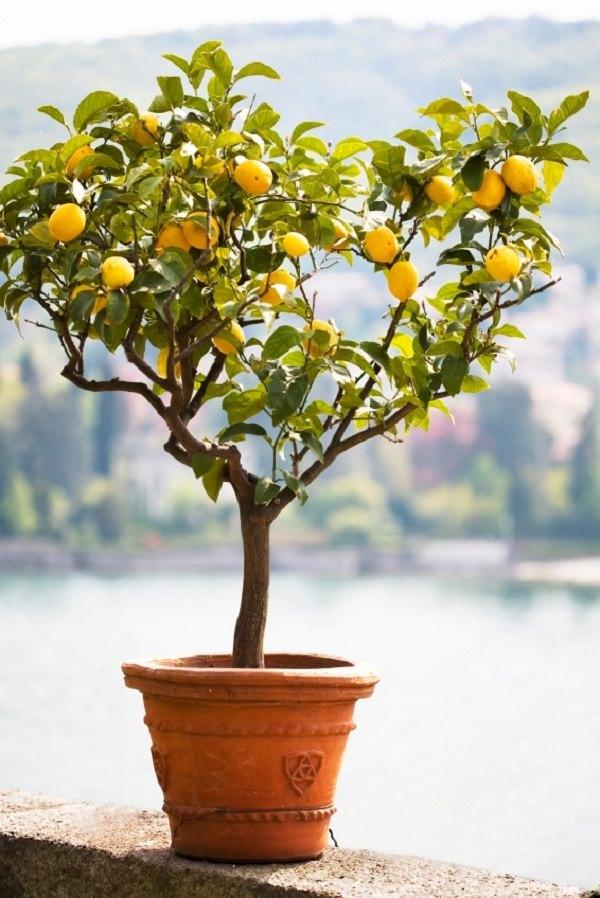

If you’re growing a lemon tree in a pot in USDA Zones 8b to 11, you don’t need to care for cold that much, but below these zones, special care is needed in harsh winters. Temperature below 30°F (-1 C) is life-threatening for the lemon tree, except ‘Meyer’ lemon variety that can tolerate some cold till 24°F (-4 C).
Freezing temperatures succumb these plants to death. Optimum temperature is around 50°F to 82°F (10°C to 28°C). To overwinter it, keep your potted plant indoors or in a greenhouse when the temperature falls below 35°F (2°C).
Pruning and Pinching Lemon Tree
Pinching encourages bushier growth, pinch growing tip when a branch is about 5 inches long. Pruning of lemon tree is best carried out when new growth starts (February – March). Be careful before pruning it, only prune diseased or dead branches because lemon stores excess food in its leaves and too much pruning can result in poor fruit crop. Also, keep looking for suckers and prune them immediately if found one.
Fertilizer for Growing Lemon Tree in a Pot
All plants of citrus family are heavy feeders, and lemon tree too requires fertilizer to produce juicy fruits, lush foliage, and fragrant blooms. Use special purpose citrus fertilizers for every citrus species plant, if unavailable use slow release fertilizer of NPK 12-6-6.
Look for a fertilizer that contains micronutrients, especially iron, manganese, and zinc. To give boost feed to your lemon tree apply a water-soluble fertilizer once in a month in growing season. Occasionally, side dress your plant with compost or well-rotted manure.
Pests and Diseases for Lemon Tree in Pot
Pests like mealy bugs, spider mites, aphids, and scales occasionally attract toward it. To get rid of them organically read this article.
Harvesting
Harvesting time depends on the type of variety you are growing and your weather conditions. The citrus fruits stop ripening once they are off the tree. To determine if the fruit is ripened, see if the fruit is heavy, soft and yellow.
Also Read: Growing Cucumbers on a Trellis
Additional Tips for Growing Lemon Tree in PotKeep your lemon tree in a less windy spot as it dislikes strong winds.If moving indoors for winter or outside for summer, acclimatize it to avoid shock.You can also do grafting to get two or more varieties from the single tree.


Image credit: the tree center
You want to grow lemons but stop because you run out of space or you don’t grow it because you live in a colder region. If this is your plight then growing a lemon tree in a pot is a smart idea. Plant it on a patio, terrace or in indoors, and you will be bestowed by its scented flowers and soft yellow citrus fruits. You can grow it in balcony too, Meyer lemon variety is perfect for kitchen and balcony gardens, especially for non-tropical zones.
Lemon Tree Varieties
Growing lemon tree from seed is a bad idea because it can take up to 4 years to produce fruits. Instead, ask in local nurseries for dwarf varieties that can do well in containers. Varieties that are most suitable for containers are Improved Meyer, Lisbon Lemon, and Dwarf Eureka. However, a lemon tree doesn’t grow too big, which means you can grow almost any variety in the pot.
*Buy a healthy lemon plant that is at least 3 years old, so that you don’t have to wait for it to start blooming and fruiting.
How to Grow a Lemon Tree in Pot
Choose a pot that is 25% bigger than the root ball of the plant. A clay pot is ideal because unlike plastic it is porous and evaporates water from sides, this helps the lemon tree to grow well as it dislikes being waterlogged. The quality and type of potting soil is an essential factor as well. For growing high yielding plants, use well draining organic potting mix.
*If you’re growing a lemon tree in a balcony or any other small space, take care of its spikes, keep the plant in a corner.
Requirements for Growing Lemon Tree in a Pot
Repot your lemon tree in every couple of years or so at the beginning of spring (in warm climates, winter is the best season). Your pot size should be according to the scale of your tree. Avoid too large or small planters, keep in mind to use a container that is one size bigger than your previously used pot.
*pH level of soil should be around 5.5 to 7 as this plant prefers slightly acidic soil to neutral soil.
Sunlight
All plants in the citrus family love full sun, around 7 to 8 hours of sunlight is essential. If growing lemon tree indoors, use grow lights to provide adequate lighting inside.
Also Read: Growing Pomegranates in Containers
Watering
The lemon tree requires consistent watering to produce healthy fruits. Giving it too much or too little water can lead to blossom and fruit drop and sometimes plant may die too. Check top 2-inch layer of soil for dryness before watering. On windy and hot days, it requires more frequent watering and slightly moist soil.
Humidity
If you are growing a lemon tree indoors, it requires a certain humidity level to thrive, 50% is ideal. You can maintain humidity by placing it on a pebble tray or using a humidifier.
Lemon Tree Care


If you’re growing a lemon tree in a pot in USDA Zones 8b to 11, you don’t need to care for cold that much, but below these zones, special care is needed in harsh winters. Temperature below 30°F (-1 C) is life-threatening for the lemon tree, except ‘Meyer’ lemon variety that can tolerate some cold till 24°F (-4 C).
Freezing temperatures succumb these plants to death. Optimum temperature is around 50°F to 82°F (10°C to 28°C). To overwinter it, keep your potted plant indoors or in a greenhouse when the temperature falls below 35°F (2°C).
Pruning and Pinching Lemon Tree
Pinching encourages bushier growth, pinch growing tip when a branch is about 5 inches long. Pruning of lemon tree is best carried out when new growth starts (February – March). Be careful before pruning it, only prune diseased or dead branches because lemon stores excess food in its leaves and too much pruning can result in poor fruit crop. Also, keep looking for suckers and prune them immediately if found one.
Fertilizer for Growing Lemon Tree in a Pot
All plants of citrus family are heavy feeders, and lemon tree too requires fertilizer to produce juicy fruits, lush foliage, and fragrant blooms. Use special purpose citrus fertilizers for every citrus species plant, if unavailable use slow release fertilizer of NPK 12-6-6.
Look for a fertilizer that contains micronutrients, especially iron, manganese, and zinc. To give boost feed to your lemon tree apply a water-soluble fertilizer once in a month in growing season. Occasionally, side dress your plant with compost or well-rotted manure.
Pests and Diseases for Lemon Tree in Pot
Pests like mealy bugs, spider mites, aphids, and scales occasionally attract toward it. To get rid of them organically read this article.
Harvesting
Harvesting time depends on the type of variety you are growing and your weather conditions. The citrus fruits stop ripening once they are off the tree. To determine if the fruit is ripened, see if the fruit is heavy, soft and yellow.
Also Read: Growing Cucumbers on a Trellis
Additional Tips for Growing Lemon Tree in PotKeep your lemon tree in a less windy spot as it dislikes strong winds.If moving indoors for winter or outside for summer, acclimatize it to avoid shock.You can also do grafting to get two or more varieties from the single tree.
0
0
文章
Miss Chen
2018年06月30日

The Aeonium genus includes about 35 succulent plants, mostly hailing from the Canary Islands. Members of the Crassulaceae family, these generally follow the growth recommendations for most succulents: lots of light, perfect drainage, and not too much water. Like other succulents, these are also highly prized for their beautiful foliage. On the most popular variety, the leaves are held on a nearly bare branch and grow in attractive rosettes that turn a deep, burgundy red in the summer time.

They are not especially common in cultivation, and if do see one, it's likely to be an immature plant. When they are young, it's easy to confuse Aeoniums with the closely related Echeverias, which are much more common in the nursery trade. It's easier, however, to tell adult plants with adequate light as the most popular species offer their spectacular leaf coloring.
Growing Conditions
Light: They like plenty of bright light, but dislike intense direct light, especially in the summer. These plants are not very tolerant of heat, so try to avoid locations where they are exposed to harmful direct heat radiation, whether from the sun or a light.
Water: When grown in containers, Aeonium like a regular supply of moisture during the growing season, which will typically be in the summer time. It's best to let the plants dry slightly between waterings, but because Aeonium have small roots, they are a bit less drought tolerant than other succulents and appreciate a steady supply of light water with good drainage.
Fertilizer: A typical cactus fertilizer can help them look their best, especially in older plants where the potting media is getting older and lost some of its nutrients.
Soil: A light, fast-draining potting soil is perfect. Cactus soils allow more latitude with watering because they hold less water, but regular potting soils can also be used.
Propagation
Many kinds of Aeonium do not clump as freely as more familiar succulents, which partially explains why they are less common in the trade (propagation is somewhat harder). However, they do root readily from leaf cuttings. Take a single leaf, allow it to dry out slightly, then place it in a seedling potting soil and keep barely moist and warm. New growth will eventually emergy. In some varieties, it's only possible to propagate from seed; this is more typical of the plants that do not branch but grow only single rosettes.
Repotting
These will not need frequent repotting. They are usually weakly rooted, so when you're repotting, be careful not to damage the roots or fragile leaves. Repot in the beginning of the growing season and keep in a warm, bright place until new growth begins to emerge.
Varieties
Collectors enjoy finding rarer Aeoniums, which grow in fantastic leaf forms and colors. Here are a few types of Aeonium that you might see:

A. arboreum. A fairly common species with mint green colored rosettes and branching growth habitate. This plant grows up to 5 feet and is easily propagated from leaf or branch cuttings. It has been extensively hybridized.
A. arboreum 'Atropurpureum'. This variety of the A. arboreum features the same green leaves that transition to purple or burgendy when exposed to sunlight. This is a very beautiful and relatively common Aeonium, compared to some of the more esoteric plants.
A arboreum 'Zwartkop.' Similar to the other two varieties, with the exception being that its leaves are dark purple and almost black. This plant is exceptionally beautiful when grown in masses.
Grower's Tips:
Aeonium are wonderful succulents that can really add visual interest to a succulent collection. They are relatively cold and heat sensitive, however, and do best in a faily temperate range. The same is true for watering: they dislike intense droughts or too much water. Ideally, Aeonium thrive in a Mediterranean climate, with mild winters and mild summers, and regular but not overwhelming water. Aeonium is vulnerable to mealybugs and aphids.

They are not especially common in cultivation, and if do see one, it's likely to be an immature plant. When they are young, it's easy to confuse Aeoniums with the closely related Echeverias, which are much more common in the nursery trade. It's easier, however, to tell adult plants with adequate light as the most popular species offer their spectacular leaf coloring.
Growing Conditions
Light: They like plenty of bright light, but dislike intense direct light, especially in the summer. These plants are not very tolerant of heat, so try to avoid locations where they are exposed to harmful direct heat radiation, whether from the sun or a light.
Water: When grown in containers, Aeonium like a regular supply of moisture during the growing season, which will typically be in the summer time. It's best to let the plants dry slightly between waterings, but because Aeonium have small roots, they are a bit less drought tolerant than other succulents and appreciate a steady supply of light water with good drainage.
Fertilizer: A typical cactus fertilizer can help them look their best, especially in older plants where the potting media is getting older and lost some of its nutrients.
Soil: A light, fast-draining potting soil is perfect. Cactus soils allow more latitude with watering because they hold less water, but regular potting soils can also be used.
Propagation
Many kinds of Aeonium do not clump as freely as more familiar succulents, which partially explains why they are less common in the trade (propagation is somewhat harder). However, they do root readily from leaf cuttings. Take a single leaf, allow it to dry out slightly, then place it in a seedling potting soil and keep barely moist and warm. New growth will eventually emergy. In some varieties, it's only possible to propagate from seed; this is more typical of the plants that do not branch but grow only single rosettes.
Repotting
These will not need frequent repotting. They are usually weakly rooted, so when you're repotting, be careful not to damage the roots or fragile leaves. Repot in the beginning of the growing season and keep in a warm, bright place until new growth begins to emerge.
Varieties
Collectors enjoy finding rarer Aeoniums, which grow in fantastic leaf forms and colors. Here are a few types of Aeonium that you might see:

A. arboreum. A fairly common species with mint green colored rosettes and branching growth habitate. This plant grows up to 5 feet and is easily propagated from leaf or branch cuttings. It has been extensively hybridized.
A. arboreum 'Atropurpureum'. This variety of the A. arboreum features the same green leaves that transition to purple or burgendy when exposed to sunlight. This is a very beautiful and relatively common Aeonium, compared to some of the more esoteric plants.
A arboreum 'Zwartkop.' Similar to the other two varieties, with the exception being that its leaves are dark purple and almost black. This plant is exceptionally beautiful when grown in masses.
Grower's Tips:
Aeonium are wonderful succulents that can really add visual interest to a succulent collection. They are relatively cold and heat sensitive, however, and do best in a faily temperate range. The same is true for watering: they dislike intense droughts or too much water. Ideally, Aeonium thrive in a Mediterranean climate, with mild winters and mild summers, and regular but not overwhelming water. Aeonium is vulnerable to mealybugs and aphids.
0
1
成长记
pzsoofi
2017年11月28日

This puppy has a big mama (27 years old) but here I am going to follow the development of this little one.


0
0
cclecombe
2017年10月18日

Does anyone on here use instagram for plants (or anything else for that matter!)? If so I'd love to follow you! Comment your usernames below 🌿😊




3
0
Tlhoward120:@nofilternosoul 😊
Estefania Pereira:its more of a daily vlog kind of account, try to take pictures of my surroundings in the places i go, it would be @tefi_pr
meriunkat:@cclecombe aww thanks 😳😄
cclecombe:@meriunkat you're super talented! I love it!!
cclecombe:@meriunkat even better, I love having new artists to follow!
显示更多
文章
Miss Chen
2017年09月29日

Tulips (Tulipa spp.) poking their heads out of the soil is one of the first signs that spring has arrived, and the brightly colored blooms don't disappoint in the weeks that follow. Hardy in U.S. Department of Agriculture plant hardiness zones 4 through 10, most tulips are perennial, and they'll bloom again next spring if you take proper care of them once they're done blooming this year.

As Blooms Fade
Once the tulip blooms have started to wilt and droop, gently pluck the remaining petals from the stem. If you prefer, cut off the dead flowers, as well as 1 to 2 inches of the stem. Don't, however, pull or snip off the plants' leaves. Allow the leaves to die back on their own, because even though the flower is gone for the year, the roots of the plant still rely on photosynthesis from the leaves to feed the plant. Deadheading the blooms prevents the plant from developing seeds and directs the plant's energy back into the bulb. To prevent disease, always use disinfected pruning tools when cutting any portion of the tulip.
After the Stems Turn Yellow
If you don't like the way the dying leaves and stems look, plant other flowers or foliage around the tulips to disguise the unsightliness. After the leaves have turned yellow and died back on their own, gently remove them from the stem. If the stems have wilted or turned yellow or brown, snip them off at ground level. Don't be tempted to do this too soon, however, or it could inhibit the tulips from returning next year. In cooler areas that experience frost and snow, cover the tulip bed with 2 to 4 inches of organic mulch like straw to protect the bulbs over winter. Use the same amount of mulch in warmer zones to preserve moisture in the soil.
Water Properly
As long as the stems of the tulips are green, you need to water them regularly. Until the stem dies, the bulb is storing up energy for the winter and water is necessary for this process. While there isn't a specific guideline regarding how much to water the tulips once they've bloomed, it's a good idea to give them a thorough watering every few days, especially if your area is experiencing a dry spell and make sure to continue watering during dry weather conditions throughout fall. Apply enough water to saturate the soil to a depth of approximately 6 inches to reach the tulip roots.

Divide and Fertilize
Older plants might need to be divided after they bloom to encourage them to return the next spring and to alleviate overcrowding that creates smaller bloom size. In warm areas of USDA zones 8 through 10, tulip bulbs require lifting and storing for six to eight weeks in the refrigerator inside a paper bag. Don't store the bulbs next to ripening fruit where the ethylene gas destroys the flower bud developing inside the bulb. When lifting and replanting, dig up the older bulbs and remove the largest "daughter" bulb. Replant each daughter 6 to 8 inches deep and spacing each bulb 5 inches apart, keeping in mind that tulips thrive in full sun. Fertilizing is usually recommended while the tulips are blooming, but you should also plan to fertilize if you divide the bulbs after they bloom. When blooming starts to occur, incorporate 2 pounds of 5-10-5 or 5-10-10 fertilizer per 100 square feet into the soil. Incorporate the fertilizer into the top inch of soil and wash it off any portion of the tulip it touches. The same type of balanced fertilizer can be applied right after you divide and replant the bulbs. When adding fertilizer to the planting hole, be sure to cover the fertilizer with approximately 1 inch of soil and do not allow the bulb to have direct contact with the fertilizer so the bulb isn't damaged or burned.

As Blooms Fade
Once the tulip blooms have started to wilt and droop, gently pluck the remaining petals from the stem. If you prefer, cut off the dead flowers, as well as 1 to 2 inches of the stem. Don't, however, pull or snip off the plants' leaves. Allow the leaves to die back on their own, because even though the flower is gone for the year, the roots of the plant still rely on photosynthesis from the leaves to feed the plant. Deadheading the blooms prevents the plant from developing seeds and directs the plant's energy back into the bulb. To prevent disease, always use disinfected pruning tools when cutting any portion of the tulip.
After the Stems Turn Yellow
If you don't like the way the dying leaves and stems look, plant other flowers or foliage around the tulips to disguise the unsightliness. After the leaves have turned yellow and died back on their own, gently remove them from the stem. If the stems have wilted or turned yellow or brown, snip them off at ground level. Don't be tempted to do this too soon, however, or it could inhibit the tulips from returning next year. In cooler areas that experience frost and snow, cover the tulip bed with 2 to 4 inches of organic mulch like straw to protect the bulbs over winter. Use the same amount of mulch in warmer zones to preserve moisture in the soil.
Water Properly
As long as the stems of the tulips are green, you need to water them regularly. Until the stem dies, the bulb is storing up energy for the winter and water is necessary for this process. While there isn't a specific guideline regarding how much to water the tulips once they've bloomed, it's a good idea to give them a thorough watering every few days, especially if your area is experiencing a dry spell and make sure to continue watering during dry weather conditions throughout fall. Apply enough water to saturate the soil to a depth of approximately 6 inches to reach the tulip roots.

Divide and Fertilize
Older plants might need to be divided after they bloom to encourage them to return the next spring and to alleviate overcrowding that creates smaller bloom size. In warm areas of USDA zones 8 through 10, tulip bulbs require lifting and storing for six to eight weeks in the refrigerator inside a paper bag. Don't store the bulbs next to ripening fruit where the ethylene gas destroys the flower bud developing inside the bulb. When lifting and replanting, dig up the older bulbs and remove the largest "daughter" bulb. Replant each daughter 6 to 8 inches deep and spacing each bulb 5 inches apart, keeping in mind that tulips thrive in full sun. Fertilizing is usually recommended while the tulips are blooming, but you should also plan to fertilize if you divide the bulbs after they bloom. When blooming starts to occur, incorporate 2 pounds of 5-10-5 or 5-10-10 fertilizer per 100 square feet into the soil. Incorporate the fertilizer into the top inch of soil and wash it off any portion of the tulip it touches. The same type of balanced fertilizer can be applied right after you divide and replant the bulbs. When adding fertilizer to the planting hole, be sure to cover the fertilizer with approximately 1 inch of soil and do not allow the bulb to have direct contact with the fertilizer so the bulb isn't damaged or burned.
0
0
meriunkat
2017年09月13日

Also on your way to Instagram go follow fortheloveofsucculents
She has helped me find the names of many of my plants with her beautiful succulent pictures.🌵🌱🌸💚🌈


She has helped me find the names of many of my plants with her beautiful succulent pictures.🌵🌱🌸💚🌈


0
0
meriunkat
2017年09月13日

Dear succulent friends i invite you to follow me at my new Instagram account: cactibrush
to see my drawings🌵🌱🌸🐈🌅🌈❤️💛💚💙💜😄😁
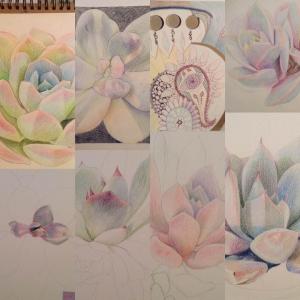
to see my drawings🌵🌱🌸🐈🌅🌈❤️💛💚💙💜😄😁

2
0
meriunkat:@Heidi Liu thanks😄
Heidi Liu:wow, pretty~~
文章
Dummer. ゛☀
2017年08月24日

Only people who have grown horseradish in their garden know how truly pungent and delicious horseradish can be. Growing horseradish in your garden is easy. Just follow these tips on how to grow horseradish and you will be harvesting horseradish for many years to come.
Planting Horseradish
A horseradish plant (Amoracia rusticana) is typically grown from a root cutting. These can be ordered from a reputable nursery or you may be able to find someone locally who is raising horseradish and would be willing to share some of their horseradish plant with you.
As soon as you get your root cutting in early spring, plant it in the ground. Dig a hole that is deep enough to stand the root up. While holding the root upright in the hole, back fill the hole until all but the crown of the root is covered. Once the root is planted, water your horseradish thoroughly, then leave it alone. When raising horseradish, you don’t need to fertilize or fuss over the plant.
Containing a Horseradish Plant
Once your horseradish plant becomes established, it will be yours for life. One thing to keep in mind is that when growing horseradish, you need to either give it lots of room or provide firm boundaries. Horseradish will spread vigorously if steps are not taken to contain it. If you do not wish for your horseradish plant to take over your garden, either grow it in a deep container or bury a plastic tub around it in the ground. This will keep the growing horseradish plant in check.
Harvesting Horseradish
There are two schools of thought when it comes to harvesting horseradish. One says that you should be harvesting horseradish in the fall, right after the first frost. The other says that you should be harvesting horseradish in early spring, when the horseradish plant needs to be divided anyway. Which of these is best is up to you. Both are acceptable. Dig down around the horseradish plant as far as you possibly can and then with your spade, gently lift the horseradish root out of the ground. Break off some of the roots and replant them in the ground. The rest of the horseradish root can be processed into ground horseradish. Raising horseradish is very easy to do. There is very little to know about how to grow horseradish. It actually does best if you plant it and then ignore it. Growing horseradish can be rewarding and tasty.

Planting Horseradish
A horseradish plant (Amoracia rusticana) is typically grown from a root cutting. These can be ordered from a reputable nursery or you may be able to find someone locally who is raising horseradish and would be willing to share some of their horseradish plant with you.
As soon as you get your root cutting in early spring, plant it in the ground. Dig a hole that is deep enough to stand the root up. While holding the root upright in the hole, back fill the hole until all but the crown of the root is covered. Once the root is planted, water your horseradish thoroughly, then leave it alone. When raising horseradish, you don’t need to fertilize or fuss over the plant.

Containing a Horseradish Plant
Once your horseradish plant becomes established, it will be yours for life. One thing to keep in mind is that when growing horseradish, you need to either give it lots of room or provide firm boundaries. Horseradish will spread vigorously if steps are not taken to contain it. If you do not wish for your horseradish plant to take over your garden, either grow it in a deep container or bury a plastic tub around it in the ground. This will keep the growing horseradish plant in check.

Harvesting Horseradish
There are two schools of thought when it comes to harvesting horseradish. One says that you should be harvesting horseradish in the fall, right after the first frost. The other says that you should be harvesting horseradish in early spring, when the horseradish plant needs to be divided anyway. Which of these is best is up to you. Both are acceptable. Dig down around the horseradish plant as far as you possibly can and then with your spade, gently lift the horseradish root out of the ground. Break off some of the roots and replant them in the ground. The rest of the horseradish root can be processed into ground horseradish. Raising horseradish is very easy to do. There is very little to know about how to grow horseradish. It actually does best if you plant it and then ignore it. Growing horseradish can be rewarding and tasty.
0
0
文章
Dummer. ゛☀
2017年08月22日

Basil (Ocimum basilicum) is often referred to as the king of herbs. Basil plants are certainly one of the most popular herbs grown in the home garden. Growing basil outdoors or in a container is very easy to do if you follow these simple steps for how to grow basil.
Tips for Growing Basil
Choose a location with great drainage. Whether you’re growing basil outdoors in the ground or in a container, the drainage needs to be excellent.
Choose a location with good sun. Another important thing to remember for basil plant care is to choose a spot where the basil plants will get plenty of good sunlight. Choose growing basil seeds or plants. Will you start by growing basil seeds or basil plants? Either option is very easy to do when growing basil outdoors.
Choose a location with good sun. Another important thing to remember for basil plant care is to choose a spot where the basil plants will get plenty of good sunlight. Choose growing basil seeds or plants. Will you start by growing basil seeds or basil plants? Either option is very easy to do when growing basil outdoors. If you choose growing basil seeds, scatter the seeds over the location that you have chosen and lightly cover with dirt. Water thoroughly. Thin to 6 inches apart once the seedling come up. If you choose growing basil plants, dig a small hole, tease out the root ball some and plant the basil plant in the ground. Water thoroughly. Wait till the temperature is right. When growing basil outdoors, it is very important to remember that basil is very sensitive to cold and even a light frost will kill it. Do not plant seeds or basil plants until all danger of frost has passed.
Harvest often. The trick to how to grow basil that is large and abundant is to harvest often. The more you harvest basil, the more the plant will grow. When harvesting, pinch off the stem right above where a pair of leaves are growing. After you harvest, two more stems will start to grow, which means twice the leaves next time you harvest! Remove flowers. Once a basil plant flowers, the leaves start to lose their good flavor. If you remove any flowers, the leaves will get their good flavor back in just a day or so. As you can see, proper basil plant care is easy. Knowing how to grow basil will provide you with large amounts of this tasty herb.

Tips for Growing Basil
Choose a location with great drainage. Whether you’re growing basil outdoors in the ground or in a container, the drainage needs to be excellent.
Choose a location with good sun. Another important thing to remember for basil plant care is to choose a spot where the basil plants will get plenty of good sunlight. Choose growing basil seeds or plants. Will you start by growing basil seeds or basil plants? Either option is very easy to do when growing basil outdoors.

Choose a location with good sun. Another important thing to remember for basil plant care is to choose a spot where the basil plants will get plenty of good sunlight. Choose growing basil seeds or plants. Will you start by growing basil seeds or basil plants? Either option is very easy to do when growing basil outdoors. If you choose growing basil seeds, scatter the seeds over the location that you have chosen and lightly cover with dirt. Water thoroughly. Thin to 6 inches apart once the seedling come up. If you choose growing basil plants, dig a small hole, tease out the root ball some and plant the basil plant in the ground. Water thoroughly. Wait till the temperature is right. When growing basil outdoors, it is very important to remember that basil is very sensitive to cold and even a light frost will kill it. Do not plant seeds or basil plants until all danger of frost has passed.

Harvest often. The trick to how to grow basil that is large and abundant is to harvest often. The more you harvest basil, the more the plant will grow. When harvesting, pinch off the stem right above where a pair of leaves are growing. After you harvest, two more stems will start to grow, which means twice the leaves next time you harvest! Remove flowers. Once a basil plant flowers, the leaves start to lose their good flavor. If you remove any flowers, the leaves will get their good flavor back in just a day or so. As you can see, proper basil plant care is easy. Knowing how to grow basil will provide you with large amounts of this tasty herb.
1
1
文章
Miss Chen
2017年08月11日

Orchids are becoming easier to find and cheaper to buy. It is not uncommon to find them now in grocery stores and garden centers ready to take home in full bloom. After you bring it home, follow some basic steps to keep the orchid alive and healthy in your home environment.

Step 1
Place the orchid in a room with bright filtered light. If close to a window, close the curtains when the light comes in on the plant or move it to a different spot. Direct sunlight can cause damage, but inadequate light is the most common reason orchids fail to bloom. Orchids need about 10 to 15 hours of light per day, which can also be from an artificial light source. Move farther from windows in hotter summer and colder winter days. Turn the pot one-quarter turn at each watering to balance light and growth.
Step 2
Maintain the temperature in a range between 60 and 80 degrees Fahrenheit. The temperatures that are comfortable for people in a home are also good for orchids. Place the pot where it will have good ventilation but no cold drafts. Be aware of drafts from doors in the winter and move the plant to a more protected spot if needed. Don't keep it too warm in winter around heaters. Orchids prefer 60 F in winter and need a rest.
Step 3
Water the orchid with distilled or rain water. Orchids don't do well with hard water and minerals will build up on the potting medium. To be extra sure about purity of water, it can be boiled to sterilize and kill any fungal or bacterial contaminants. Water once per week. Touch the growing medium to see if it feels moist and water if dry. Let water drain through and out of the pot. When the orchid is blooming and actively growing, the pot can be immersed in the water for 30 minutes to allow the bark to soak up more water and then drain well. In the summer, this would be good at every other week waterings opposite feedings.
Step 4
Apply a balanced liquid all-purpose fertilizer at one-half the strength suggested on the label. Orchids growing in bark should receive a fertilizer higher in nitrogen, such as 30-10-10. Fertilize during one or two of the watering days per month. Fertilizer formulas are also available specifically for growing orchids. Orchids are epiphytic and get nutrients from the air and watering. The use of lower-strength fertilizer and allowing it to drain well prevents the buildup of salts and minerals in the medium.

Step 5
Adjust the humidity to keep it in the range of 60 to 70 percent around the plant. This can be done by placing a bowl of water next to the plant or setting the pot on a dish with water and pebbles inside. Keep the pot and aerial roots out of standing water. Green florists foam is a good choice to put in the bottom of a decorator pot and then set the orchid in its own pot on top. The foam will absorb and evaporate the excess water around the plant without standing stagnant water.
Step 6
Use a lightweight soilless potting medium that is able to hold moisture. One suggested mix is one part peat moss, one part charcoal and two parts of 1/2-inch pine bark. Many garden centers and nurseries sell orchid potting medium mixes and mesh baskets for planting orchids. A mesh pot or basket provides ventilation to prevent rot. Allow the aerial roots to hang outside the pot to prevent rot.

Step 1
Place the orchid in a room with bright filtered light. If close to a window, close the curtains when the light comes in on the plant or move it to a different spot. Direct sunlight can cause damage, but inadequate light is the most common reason orchids fail to bloom. Orchids need about 10 to 15 hours of light per day, which can also be from an artificial light source. Move farther from windows in hotter summer and colder winter days. Turn the pot one-quarter turn at each watering to balance light and growth.
Step 2
Maintain the temperature in a range between 60 and 80 degrees Fahrenheit. The temperatures that are comfortable for people in a home are also good for orchids. Place the pot where it will have good ventilation but no cold drafts. Be aware of drafts from doors in the winter and move the plant to a more protected spot if needed. Don't keep it too warm in winter around heaters. Orchids prefer 60 F in winter and need a rest.
Step 3
Water the orchid with distilled or rain water. Orchids don't do well with hard water and minerals will build up on the potting medium. To be extra sure about purity of water, it can be boiled to sterilize and kill any fungal or bacterial contaminants. Water once per week. Touch the growing medium to see if it feels moist and water if dry. Let water drain through and out of the pot. When the orchid is blooming and actively growing, the pot can be immersed in the water for 30 minutes to allow the bark to soak up more water and then drain well. In the summer, this would be good at every other week waterings opposite feedings.
Step 4
Apply a balanced liquid all-purpose fertilizer at one-half the strength suggested on the label. Orchids growing in bark should receive a fertilizer higher in nitrogen, such as 30-10-10. Fertilize during one or two of the watering days per month. Fertilizer formulas are also available specifically for growing orchids. Orchids are epiphytic and get nutrients from the air and watering. The use of lower-strength fertilizer and allowing it to drain well prevents the buildup of salts and minerals in the medium.

Step 5
Adjust the humidity to keep it in the range of 60 to 70 percent around the plant. This can be done by placing a bowl of water next to the plant or setting the pot on a dish with water and pebbles inside. Keep the pot and aerial roots out of standing water. Green florists foam is a good choice to put in the bottom of a decorator pot and then set the orchid in its own pot on top. The foam will absorb and evaporate the excess water around the plant without standing stagnant water.
Step 6
Use a lightweight soilless potting medium that is able to hold moisture. One suggested mix is one part peat moss, one part charcoal and two parts of 1/2-inch pine bark. Many garden centers and nurseries sell orchid potting medium mixes and mesh baskets for planting orchids. A mesh pot or basket provides ventilation to prevent rot. Allow the aerial roots to hang outside the pot to prevent rot.
0
0
文章
Dummer. ゛☀
2017年08月04日

Think Outside the Pot
If you've got a postage stamp for a yard or you're such an avid gardener that you've filled all your space, it's time to explore new gardening territory with vertical gardening. Follow the tips below for a few traditional and innovative ways to add new foliage to your small or plant-packed garden.

The Traditional Way: Grow Vines
Vines are growing machines. Some of them can grow to 50 feet in length. If you have a fence or wall in need of livening up, try vines. Clematis is tame, while trumpet vines are more adventurous and can tear up your siding, so be sure to pick a variety that's suitable to your setting. You can put up a trellis on your wall or fence for your vine to follow, or build an arbor or pergola. Either way, you can create a stunning assortment of flowers and greenery with vines alone, and attracts birds and butterflies to your yard.

Grow Down
With planters, you can create your own version of the Hanging Gardens of Babylon. Put containers along balconies or ledges and add trailing plants such as petunias or million bells, which will create a green and flowery curtain that sways in the breeze. Your hanging garden can also provide some much-needed shade during a hot summer.
Make a Living Wall
Grow plants on your interior or exterior walls using a hanging structure like ELT's living walls. You can use just about any kind of plant that has shallow roots to create beautiful designs that look more like a tapestry than a garden. ELT's vertical garden system is a 20 by 24 inch rectangular plastic structure that has 25 containers in which to place your plants. You can fasten any number of rectangles together to cover any surface you want. They also make a vertical garden for interiors, either on the floor or as a frame on the wall. If you have a sloped roof that's exposed to sun all day, you can put some rectangles up to create an inexpensive green roof. Green roofs are becoming popular in Europe as a means of slowing down runoff and cooling buildings without air conditioning.
If you've got a postage stamp for a yard or you're such an avid gardener that you've filled all your space, it's time to explore new gardening territory with vertical gardening. Follow the tips below for a few traditional and innovative ways to add new foliage to your small or plant-packed garden.

The Traditional Way: Grow Vines
Vines are growing machines. Some of them can grow to 50 feet in length. If you have a fence or wall in need of livening up, try vines. Clematis is tame, while trumpet vines are more adventurous and can tear up your siding, so be sure to pick a variety that's suitable to your setting. You can put up a trellis on your wall or fence for your vine to follow, or build an arbor or pergola. Either way, you can create a stunning assortment of flowers and greenery with vines alone, and attracts birds and butterflies to your yard.

Grow Down
With planters, you can create your own version of the Hanging Gardens of Babylon. Put containers along balconies or ledges and add trailing plants such as petunias or million bells, which will create a green and flowery curtain that sways in the breeze. Your hanging garden can also provide some much-needed shade during a hot summer.

Make a Living Wall
Grow plants on your interior or exterior walls using a hanging structure like ELT's living walls. You can use just about any kind of plant that has shallow roots to create beautiful designs that look more like a tapestry than a garden. ELT's vertical garden system is a 20 by 24 inch rectangular plastic structure that has 25 containers in which to place your plants. You can fasten any number of rectangles together to cover any surface you want. They also make a vertical garden for interiors, either on the floor or as a frame on the wall. If you have a sloped roof that's exposed to sun all day, you can put some rectangles up to create an inexpensive green roof. Green roofs are becoming popular in Europe as a means of slowing down runoff and cooling buildings without air conditioning.
0
1








